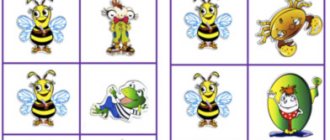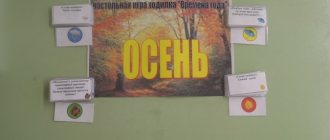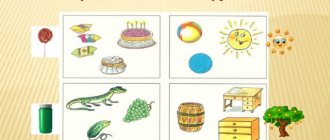What children need to know about emotions
By the senior preschool age, the child has already formed an idea of human emotions, which include:
- joy
- sadness
- fear
- anger
- resentment
- astonishment
Children define and name psychological states, briefly describe them, and give examples of everyday situations in which a person experiences them.
Pictures for children depicting emotions teach the child to reason, describe cause-and-effect relationships, and analyze his own life experience.
During speech therapy work, it is useful to offer preschool children topics related to people’s experiences to compose narrative stories. For example:
- Is it only humans who have feelings?
- What are positive and negative emotions?
- When am I happy and when am I sad?
Emotions can be divided into pairs with opposite meanings. For example: joy - sadness, disgust - admiration, boredom - interest, etc. Children should be able to recognize and name the feeling of the character in the picture, but also select antonyms for the definition. Exercises in this format allow you to more firmly consolidate the characteristics of emotions.
Children should know that we can learn about a person’s psychological state both from words and by observing actions and behavior. Each emotion has a corresponding dictionary and a set:
- gestures
- facial expressions,
- actions
It is useful to have conversations with older preschoolers about how their emotional state needs to be managed, especially when it comes to negative feelings. You cannot give free rein to anger, irritation, or sadness. Express feelings only in socially acceptable ways. Children will be interested to know that in countries around the world people express feelings in different ways.
“We splash out negative feelings on paper”
It is known that one of the important problems in raising a child is related to the distribution of energy in the child’s body. Children actively explore the world around them, showing a wide variety of emotions. Drawing can release spontaneity in young children and help them pay attention to their problems. With the help of a drawing, you can also calm a child, removing his irritation, aggression and anger.
By translating unrealized, aggressive energy into creativity, the child sublimates his fear and similar negative emotions.
Important!
When your child is irritated or feeling aggressive, encourage him to take his anger out on a piece of paper.
You can use any tools to “outburst” emotions: paints, markers or pencils. It is especially good to do this with the help of wax pencils - on the one hand, children love to draw with them, on the other hand, wax pencils are quite hard and difficult to break. I recommend them.
Exercise
At a moment of aggression or anger, ask the child to transfer everything he feels onto a sheet of paper in the form of some lines, spots or specific images (suggest doing this with wax pencils on A4 sheets). Tell your child that he can tap, hit, or poke the paper with the pencil as much as he wants.
When the drawing is finished, let the child speak out, no matter how emotional his story may be. After this, turn on calm music and ask the child to listen to it and to himself. Ask him to look carefully at his drawing and “calm” it with watercolors, choosing the color that he likes best. Make sure that the drawing is completely covered with this color. Since the drawing is made with wax pencils, it will not be painted over entirely, but will appear again and again, as it were. This will allow the child to see and realize that his “angry” and “aggressive” drawing, covered with his favorite color, no longer looks like that at all. By this moment, his body, arms and legs will be completely relaxed, and the desire to be capricious and angry will completely disappear.
Defining emotions for children
For speech therapy work with students in the senior and preparatory groups of kindergarten, use the following list of emotional states:
Joy is a positive emotion familiar to everyone. We feel joy when something good happens. A person can express this feeling through words and actions. Signs of a joyful state are laughter and smiling. Experiencing joy feels good, as does bringing it to others.
Sadness is a feeling that appears when we learn or think about something sad. Sadness cannot be called a strong emotion; it passes quickly. This does not mean that you should not allow yourself to be sad; sometimes every person needs it. But you shouldn’t indulge too much in a sad mood; it’s more useful to try to quickly get rid of it by doing something pleasant or useful.
Anger is anger, strong irritation towards someone or something. Feeling angry is not pleasant, but sometimes it happens to everyone. It is a strong emotion that can cause trouble for us and others. It is important to explain to children how to manage anger and be able to express it correctly. If a person is often angry, then it is difficult for him to find friends, he is often lonely.
Fear is a strong negative emotion that people experience if they are threatened by something. The danger can be real or expected or imaginary. Every child has repeatedly felt fear, so he can easily recognize its image in illustrations or photographs, and also give examples of events, objects and phenomena that cause this feeling in them. Children should know that fear varies in intensity, from fear to horror. It is important to explain to children that this emotion is necessary for a person, as it warns of danger. It can be added that the color black is often used to illustrate fear in pictures.
Admiration is a pleasant emotion that arises when encountering something very beautiful or unusual. Admiration can be caused by: an unusual toy, a garden in bloom, an elegant girl. People, expressing admiration, use special exclamations: (oh, ah, wow, wow) and words (really, amazing, wonderful, wonderful, extraordinary). Admiration can be so strong that it is very difficult to express your feeling in words. From a photograph or drawing, preschool children can easily recognize a person who admires something, although it is difficult for them to describe his feelings; this requires special speech therapy training.
Shame is an unpleasant feeling that occurs when we have done something bad and regret it. The older the children, the easier it is to explain to them the essence and meaning of this emotional state. Signs of shame are not only certain facial expressions, but also redness of certain parts of the face (cheeks, ears, neck). Knowing this feature will help preschoolers quickly and easily recognize shame in drawings (by the way, this sign can often be seen in story pictures for children and even in selfies) and in the behavior of people around them. You can have a conversation with children 6-7 years old about the difference between shame and shyness; these states are easy to confuse.
Resentment - a person feels resentment when someone’s action seems unfair to him. Some people are touchy, others rarely experience this emotion. It is difficult to describe the state of resentment; preschool children should be able to recognize its image. To do this, you can use both schematic images (for example, emoticons - simple pictures of emotions for children), and realistic drawings, color or black and white photographs. By the way, it is convenient to print such visual material from collections and presentations on specialized speech therapy websites.
LiveInternetLiveInternet
Quote from Mamin_dnevnik message
Read in full In your quotation book or community!
Cards for activities with children - Emotions
Teach children to recognize emotions (joy, sadness, fear, anger) by facial expressions and intonation; depict these emotions using gestures, movements, and voice. Contribute to the enrichment of the emotional sphere Card index of games for the development of the emotional-volitional sphere in children 5-6 years old. “LET'S SAY HELLO” (from 5 years old) Purpose: the exercise continues acquaintance, creates a psychologically relaxed atmosphere. At the beginning of the exercise, we talk about different ways of greeting, real and comic. Children are invited to greet with their shoulder, back, hand, nose, cheek, come up with their own unusual way of greeting for today's lesson and say hello to them. (For each subsequent lesson, a new, previously unused way of greeting is invented! “STAND UP, ALL THOSE WHO ..." (from 5 years old) Purpose: the exercise is aimed at developing attention, observation, as well as continuing group acquaintance. The leader gives the task: “Stand up, everyone those who... - like to run, - enjoy good weather, - have a younger sister, - like to give flowers, etc. If desired, children can play the role of leader. After completing the exercise, children are asked questions summing up the game: - Now we’ll see , who in our group turned out to be the most attentive. Which of the guys remembered who in our group likes sweets? Who has a younger sister? Etc. Then the questions become more complicated (include two variables): - Who is in our group? group likes sweets and has a younger sister? Each question is addressed to a specific child, if he cannot answer himself, the group helps him" ————————————————————————— —————————————- No. 17 “DESCRIBE A FRIEND” (from 5 years old) Goal: development of attentiveness and the ability to describe what you saw, continuation of acquaintance. The exercise is performed in pairs (by all participants at the same time). Children stand with their backs to each other and take turns describing the hairstyle, clothes and face of their partner. Then the description is compared with the original and a conclusion is drawn about how accurate the child was. ——————————————————————————————————————— No. 18 “WHAT HAS CHANGED” (from 5 years old) Goal: development of attention and observation necessary for effective communication. Each child takes turns becoming a driver. The driver leaves the room. During this time, the group makes several changes in the children’s clothing and hairstyle; you can move to another place (but no more than two or three changes; all changes made must be visible). The driver’s task is to correctly notice the changes that have occurred. ________________________________________________________________________ No. 19 “HOW DO YOU FEEL?” (from 5 years old) Goal: development of attentiveness, empathy, the ability to feel the mood of another. The exercise is performed in a circle. Each child carefully looks at his neighbor on the left and tries to guess how he feels and talks about it. The child, whose condition is described, listens and then agrees with what was said or disagrees, complements. ——————————————————————————————————————— No. 20 “MY MOOD” (from 5 years old) Goal: developing the ability to describe one’s mood, recognize the moods of others, and develop empathy. Children are invited to tell others about their mood: you can draw it, you can compare it with some color, animal, state, you can show it in motion - it all depends on the child’s imagination and desire. ——————————————————————————————————————— No. 21 “A GIFT FOR EVERYONE (FLOWER - SEVEN-FLOWER) "(from 5 years old) Goal: development of a sense of team, the ability to make friends, make the right choice, cooperate with peers. The children are given the task: “If you were a wizard and could work miracles, what would you give to all of us now?” Or: “If we had a seven-flowered flower, what wish would you make?” Each child makes one wish by tearing one petal from a common flower. Fly, fly, petal, through the west to the east, through the north, through the south, come back, having made a circle, as soon as you touch the ground, be it in my opinion. Order that... At the end, you can hold a competition for the best wish for everyone. ——————————————————————————————————————— No. 22 “PORTRAIT OF THE BEST FRIEND” (from 5 years) Goal: development of analysis and self-analysis. Children are given the task of drawing a portrait of their best friend. Then a conversation is held: - Who do you consider your best, best friend? What qualities does this person have? Do you want to be considered a good friend? What should you do for this, how should you behave? During the general discussion, rules for joyful communication are formulated, which are drawn in a schematic form accessible to children or written down on a piece of Whatman paper in block letters (if the children already know how to read). For example: - Help your friends. - Share with them, learn to play and study together. - Stop your friend if he is doing something bad. Tell him if he's wrong about something. - Don’t quarrel, don’t argue over trifles; play together with everyone. - Do not envy. - If you did something bad, don’t be afraid to admit it, apologize. — Calmly accept the advice and help of other guys. - Don't be happy when someone loses. If you can, help him. - If you lose, don’t take your anger out on others, maybe you’ll win next time. _____________________________________________________________________________ No. 23 “ETUDE ON DIFFERENT POSITIONS IN COMMUNICATION” (from 5 years old) Goal: to get a feel for different positions in communication. Children are given the task to split into pairs. Communication in pairs takes place in a dialogue mode. Interesting and relevant topics for children are offered for communication: “My favorite animal”, “My happiest day last month”, etc. First, the communication situation is organized when both children sit facing each other, then one child sits on a chair, and the other stands near his chair (the children change places), then the children, sitting on the chair with their backs to each other, continue the conversation. Afterwards, the children are asked about the impressions and mood that arose during the communication process. How did you like to communicate? Why? ———————————————————————————————————————- No. 24 “HANDS ARE ACQUAINTING. HANDS ARE FIGHTING. HANDS MAKE PEACE” (from 5 years old) Goal: correlation of a person and his tactile image, removal of bodily barriers; developing the ability to express one’s feelings and understand the feelings of another through touch. The exercise is performed in pairs with eyes closed, children sit opposite each other at arm's length. An adult gives tasks (each task takes 2-3 minutes): - Close your eyes, stretch out your hands towards each other, introduce yourself with one hand. Try to get to know your neighbor better. Put your hands down” - Stretch your hands forward again, find your neighbor’s hands. Your hands are fighting. Put your hands down. - Your hands are looking for each other again. They want to make peace. Your hands make peace, they ask for forgiveness, you part as friends. Discuss how the exercise went, what feelings arose during the exercise, what did you like more? ——————————————————————————————————————— No. 25 “MAGIC TOOLS OF UNDERSTANDING” (from 5 years ) Introductory conversation. Goal: awareness that it is possible to help a person who is sad or ill, that everyone has the power to help everyone who needs it, understanding what exactly can be done for this. - What helps you when it’s difficult, bad, when you’ve done something wrong, when you’ve been offended? — What special things can people do with whom we enjoy communicating, what distinguishes them? (smile, ability to listen, eye contact, kind gentle voice, soft unsharp gestures, pleasant touches, polite words, ability to understand a person). — Why can we call these means of understanding “magical”? - Can you and I use these “magic” remedies when? ———————————————————————————————————————- No. 26 “FACES” (from 5 years old) Goal : Helps develop understanding of facial expressions and facial expressions. The leader hangs various pictures and masks on the board: - joy, - surprise, - interest, - anger, anger, - fear, - shame, - contempt, - disgust. The children’s task is to determine what feeling the mask expresses. ___________________________________________________________________________ No. 27 “MASKS” (from 5 years old) Goal: the ability to distinguish facial expressions, independently consciously use facial expressions to express your emotions. Each of the participants is given a task - to express grief, joy, pain, fear, surprise with the help of facial expressions... The remaining participants must determine what the participant was trying to portray. ______________________________________________________________________________ No. 28 “ROLE PLAYING SITUATIONS” (from 5 years old) Purpose: the exercise is performed in pairs, it is aimed at specific study, the use of “magic” means of understanding, the development of empathy, the use of already familiar means of understanding. Using the “magic” means of understanding, children must help: 1) a crying child who has lost his ball; 2) mom came home from work, she was very tired; 3) a friend in class is sitting sad, his mother is sick; 4) your friend is crying, he received a bad grade; 5) the girl next door asked you to make an applique for her... It is necessary to select so many situations so that each child can complete the task. ———————————————————————————————————————- No. 29 “DRAWING” (from 5 years old) Goal : development of empathy, creative imagination. The children are given the task: “Draw a kind animal and call it by an affectionate name, reward it with some magical means of understanding.” Drawing is carried out to the accompaniment of quiet, calm music, with paints or bright crayons, felt-tip pens on unlined white sheets. Then a competition is held for the kindest animal. The winner is awarded a certificate. ——————————————————————————————————————— No. 30 “ARTIST OF THE WORD” (from 5 years old) Goal : development of the ability to describe what is observed, the ability to highlight details essential for the description, the use of acceptable, non-offensive words, expansion of the active and passive vocabulary of children. Each child takes turns thinking of someone from the group and begins to draw his verbal portrait - his external characteristics (and, if possible, internal, psychological ones), without specifically naming this person’s name. Taking into account the level of development of children, you can offer them exercises on associative perception. (What animal does it look like? What flower? What piece of furniture? etc.) ————————————————————————————— —————————- No. 31 “LET’S MAKE A GIFT IN A CIRCLE FOR EACH OTHER” (from 5 years old) Goal: to develop in children a feeling for each other, an understanding of the other’s mood, the development of empathy. The presenter instructs everyone to give their neighbor on the right a gift, but not a specific gift, but a fictitious one: “What would you like to give to this particular person? Give the gift that you think he especially needs right now.” A gift can be described in words or shown with gestures. _________________________________________________________________________ No. 32 “TOY” (from 5 years old) Purpose: role-playing situations, practicing skills of effective interaction, empathy, and the ability to cooperate. The exercise is performed in pairs. One child from the couple is the owner of a beautiful and very beloved toy, which he loves to play with. Another child really wants to play with this toy. His task is to persuade the owner of the toy to let him play with it. Important: when performing this exercise, the child who owns the toy is given any toy that he should present as his favorite. As soon as the owner of the toy gives it to the asking child, the exercise is interrupted and the child is asked why he gave the toy.
Drawn pictures
Emotions in pictures for children, used for classes on speech development, are presented in several versions: images of adults and children, people or fairy-tale characters. Printed pictures and drawings created by children are suitable for the development of speech in preschoolers.
Invite the children to draw themselves or another person experiencing a certain feeling. Drawing up a verbal explanation for such a picture is a speech therapy exercise that the children do willingly.
If children are not yet able to cope with independent depictions of emotional states, it is worth inviting them to create a collage from pre-prepared and printed facial details. Preschoolers aged 6-7 years are able to recreate emotions on paper on their own, but for younger children it is worth using ready-made templates and samples.
In speech therapy work, you can use not only drawing, but also coloring. Thematic coloring books are a useful and exciting material that is indispensable for girls and boys in kindergarten and at home.
It is important to first thoroughly study with children not only the names of different emotions, but also those artistic techniques that allow you to accurately convey one or another psychological state of a person. The use of pictograms can be very helpful in this regard.
Technique “Drawing Fear”
All children experience fear. This is the fear of the dark, big and angry dogs, fairy-tale monsters, illness, etc. and so on. Sometimes fear has such a strong impact on the child’s psyche that the child begins to hear and see only information related to his fear. Thus, the child increases the feeling of fear, and this entails muscle tension, stiffness of the whole body, and weakening of attention. Therefore, it is so important to teach a child to relax by expressing his fear in creativity.
Exercise
For the art therapeutic technique “Drawing Fear” you will need: gouache or watercolor, A4 paper, brushes, a jar of water, a “Fear” pictogram.
Show your child the fear pictogram and ask him to paint fear on his face in front of the mirror. Then ask to draw the face of a person experiencing fear on paper. Make sure that by the end of the work the entire sheet is filled out. “Fear” pictogram
When the drawing is finished, invite your child to remember the most terrible incident in his life and talk about it. And then ask the child if he likes the fear that he drew, and would he like to destroy it? Offer to crumple the drawing or tear it into small pieces, and then set it on fire so that the child can see that his fear has burned away. After the drawing burns out, invite your child to throw the ashes into the toilet and rinse with water or scatter in the air outside. The main thing is that the baby chooses what to do with the ashes. After this procedure, you need the child to wash his hands clean and dry them with a clean towel.
Pictograms
Schematic representations of various emotions greatly help children in learning, remembering and recognizing human emotional states. Especially in the early stages of getting to know this topic. Various sets of “Emotions emoticons pictures for children” contain cards with a conventional image of anger, joy and other feelings.
Games with pictograms
Games with pictograms are a whole area in the work of speech therapists and psychologists. Schematic images of emotions (faces) are excellent material for stimulating a child’s speech activity. Here are some examples of using such images:
Pick and name
Prepare pictures of pictograms with different emotions and feelings for children. The task is to find out this or that state, give it a name, and then come up with a situation in which it would be appropriate. Children can use both their personal experience and remember the heroes of famous fairy tales and cartoons. It’s okay if at first the descriptions of emotions sound childish, gradually regular speech training will help these stories become more perfect.
Find a match
If you take a cut set of emoticon pictures and mix them up, you will get an exciting game for a team of preschoolers, which can also be used in speech development classes. The task is to collect all the images. It is important that each emoticon accurately expresses a particular feeling, then the emotion will be easier to recognize and describe.
Transformations of moods
For this game you need to select the following emoticons, pictures of emotions for children, which can be sorted into opposite pairs. For example, sadness-joy, admiration-disgust, etc. Ask the children to take one card or a round smiley face, and then match the selected picture with a pair. After this, you can invite the children to come up with a story about what could turn one emotion into another.
Koloboks
The image of a kolobok is similar to a smiley face, so also use pictures with this character as pictograms illustrating emotions.
Use Kolobok’s drawings on a transparent background, so it’s easier for children to analyze the psychological state of the hero, and not the plot twists that happen to him.
There are many options for games with this fairy-tale character. For example, tell a Russian fairy tale, describing the emotions of Kolobok and other characters. The use of puppet theater or masks will help make this activity productive.
Emotions in the country of Smeshariya
Toys from the cartoon Smeshariki - material for classes on speech development in preschool educational institutions and at home. Images of funny round characters can be used to illustrate emotional states. Buy a ready-made manual or make it yourself, cutting out and signing characters from a magazine or book.
Offer the children pictures of Smeshariki and ask them to name the feeling that Nyusha, Kar-Karych, Krosh and other characters experience.





